A Landscape Restoration Initiative Reverses Desertification with High Spatiotemporal Variability in the Hinterland of Northwest China
Abstract
:1. Introduction
2. Materials and Methods
2.1. Study Area
2.2. The CTSRB
2.3. Data and Methods
2.3.1. Data
2.3.2. Data Processing and Statistical Analysis
3. Results
3.1. The Spatiotemporal Distribution of Vegetation Growth
3.2. Changes in Vegetation Growth before and after the Implementation of the CTSRB
3.2.1. Mean Value Changes
3.2.2. Cumulative Distributions of GDVI Values
3.3. Vegetation Growth Trends
3.4. Vegetation Growth Stability
4. Discussion
5. Conclusions
Author Contributions
Funding
Data Availability Statement
Acknowledgments
Conflicts of Interest
References
- Liu, J.G.; Diamond, J. China’s Environment in a Globalizing World. Nature 2005, 435, 1179–1186. [Google Scholar] [CrossRef] [PubMed]
- Xu, J.; Yin, R.; Li, Z.; Liu, C. China’s Ecological Rehabilitation: Unprecedented Efforts, Dramatic Impacts, and Requisite Policies. Ecol. Econ. 2006, 57, 595–607. [Google Scholar] [CrossRef]
- Kareiva, P.; Watts, S.; McDonald, R.; Boucher, T. Domesticated Nature: Shaping Landscapes and Ecosystems for Human Welfare. Science 2007, 316, 1866–1869. [Google Scholar] [CrossRef] [PubMed]
- Vina, A.; McConnell, W.J.; Yang, H.; Xu, Z.; Liu, J. Effects of Conservation Policy on China’s Forest Recovery. Sci. Adv. 2016, 2, e1500965. [Google Scholar] [CrossRef] [PubMed]
- McGlone, C.M.; Springer, J.D.; Covington, W.W. Cheatgrass Encroachment on a Ponderosa Pine Forest Ecological Restoration Project in Northern Arizona. Ecol. Restor. 2009, 27, 37–46. [Google Scholar] [CrossRef]
- Reid, K.A.; Williams, K.J.H.; Paine, M.S. Hybrid Knowledge: Place, Practice, and Knowing in a Volunteer Ecological Restoration Project. Ecol. Soc. 2011, 16, 19. [Google Scholar] [CrossRef]
- Manjaribe, C.; Frasier, C.L.; Rakouth, B.; Louis, E.E. Ecological Restoration and Reforestation of Fragmented Forests in Kianjavato, Madagascar. Int. J. Ecol. 2013, 2013, 726275. [Google Scholar] [CrossRef]
- Brancalion, P.H.S.; Villarroel Cardozo, I.; Camatta, A.; Aronson, J.; Rodrigues, R.R. Cultural Ecosystem Services and Popular Perceptions of the Benefits of an Ecological Restoration Project in the Brazilian Atlantic Forest. Restor. Ecol. 2014, 22, 65–71. [Google Scholar] [CrossRef]
- Aeschbach-Hertig, W.; Gleeson, T. Regional Strategies for the Accelerating Global Problem of Groundwater Depletion. Nat. Geosci. 2012, 5, 853–861. [Google Scholar] [CrossRef]
- Ouyang, Z.; Zheng, H.; Xiao, Y.; Polasky, S.; Liu, J.; Xu, W.; Wang, Q.; Zhang, L.; Xiao, Y.; Rao, E.; et al. Improvements in Ecosystem Services from Investments in Natural Capital. Science 2016, 352, 1455–1459. [Google Scholar] [CrossRef]
- Hua, F.; Wang, X.; Zheng, X.; Fisher, B.; Wang, L.; Zhu, J.; Tang, Y.; Yu, D.W.; Wilcove, D.S. Opportunities for Biodiversity Gains under the World’s Largest Reforestation Programme. Nat. Commun. 2016, 7, 12717. [Google Scholar] [CrossRef] [PubMed]
- Moore, J.C.; Chen, Y.; Cui, X.; Yuan, W.; Dong, W.; Gao, Y.; Shi, P. Will China Be the First to Initiate Climate Engineering? Earths Future 2016, 4, 588–595. [Google Scholar] [CrossRef]
- Xu, W.H.; Xiao, Y.; Zhang, J.J.; Yang, W.; Zhang, L.; Hull, V.; Wang, Z.; Zheng, H.; Liu, J.G.; Polasky, S.; et al. Strengthening Protected Areas for Biodiversity and Ecosystem Services in China. Proc. Natl. Acad. Sci. USA 2017, 114, 1601–1606. [Google Scholar] [CrossRef] [PubMed]
- Tong, X.W.; Brandt, M.; Yue, Y.M.; Horion, S.; Wang, K.L.; De Keersmaecker, W.; Tian, F.; Schurgers, G.; Xiao, X.M.; Luo, Y.Q.; et al. Increased Vegetation Growth and Carbon Stock in China Karst via Ecological Engineering. Nat. Sustain. 2018, 1, 44–50. [Google Scholar] [CrossRef]
- Lu, F.; Hu, H.F.; Sun, W.J.; Zhu, J.J.; Liu, G.B.; Zhou, W.M.; Zhang, Q.F.; Shi, P.L.; Liu, X.P.; Wu, X.; et al. Effects of national ecological restoration projects on carbon sequestration in China from 2001 to 2010. Proc. Natl. Acad. Sci. USA 2018, 115, 4039–4044. [Google Scholar] [CrossRef] [PubMed]
- Yu, Z.Q.; Liu, X.; Zhang, J.Z.; Xu, D.Y.; Cao, S.X. Evaluating the net value of ecosystem services to support ecological engineering: Framework and a case study of the Beijing Plains afforestation project. Ecol. Eng. 2018, 112, 148–152. [Google Scholar] [CrossRef]
- Carlucci, M.B.; Brancalion, P.H.S.; Rodrigues, R.R.; Loyola, R.; Cianciaruso, M.V. Functional traits and ecosystem services in ecological restoration. Restor. Ecol. 2020, 28, 1372–1383. [Google Scholar] [CrossRef]
- Yang, S.Q.; Zhao, W.W.; Liu, Y.X.; Wang, S.; Wang, J.; Zhai, R.J. Influence of land use change on the ecosystem service trade-offs in the ecological restoration area: Dynamics and scenarios in the Yanhe watershed, China. Sci. Total Environ. 2018, 644, 556–566. [Google Scholar] [CrossRef]
- Cui, H.L.; Liu, M.; Chen, C. Ecological Restoration Strategies for the Topography of Loess Plateau Based on Adaptive Ecological Sensitivity Evaluation: A Case Study in Lanzhou, China. Sustainability 2022, 14, 2858. [Google Scholar] [CrossRef]
- Wang, G.Y.; Innes, J.L.; Lei, J.F.; Dai, S.Y.; Wu, S.W. Ecology—China’s Forestry Reforms. Science 2007, 318, 1556–1557. [Google Scholar] [CrossRef]
- Chen, A.; Yang, X.C.; Guo, J.; Xing, X.Y.; Yang, D.; Xu, B. Synthesized remote sensing-based desertification index reveals ecological restoration and its driving forces in the northern sand-prevention belt of China. Ecol. Indic. 2021, 131, 108230. [Google Scholar] [CrossRef]
- Wang, L.; Qiu, Y.N.; Han, Z.Y.; Xu, C.; Wu, S.Y.; Wang, Y.; Holmgren, M.; Xu, Z.W. Climate, topography and anthropogenic effects on desert greening: A 40-year satellite monitoring in the Tengger desert, northern China. Catena 2022, 209, 105851. [Google Scholar] [CrossRef]
- Cortina-Segarra, J.; García-Sánchez, I.; Grace, M.; Andrés, P.; Baker, S.; Bullock, C.; Decleer, K.; Dicks, L.V.; Fisher, J.L.; Frouz, J.; et al. Barriers to ecological restoration in Europe: Expert perspectives. Restor. Ecol. 2020, 29, e13346. [Google Scholar] [CrossRef]
- Fernandes, G.W.; Vale, M.M..; Overbeck, G.E.; Bustamante, M.M.C.; Grelle, C.E.V.; Bergallo, H.G.; Magnusson, W.E.; Akama, A.; Alves, S.S.; Amorim, A.; et al. Dismantling Brazil’s science threatens global biodiversity heritage. Perspect. Ecol. Conserv. 2017, 15, 239. [Google Scholar] [CrossRef]
- Iftekhar, M.S.; Polyakov, M.; Ansell, D.; Gibson, F.; Kay, G.M. How economics can further the success of ecological restoration. Conserv. Biol. 2017, 31, 261–268. [Google Scholar] [CrossRef] [PubMed]
- Platz, M.C. Coral Reef Restoration Monitoring through an Environmental Engineering and Social-Ecological Lens. Ph.D. Thesis, University of South Florida, Tampa, FL, USA, 2022. [Google Scholar]
- Gomez-Ros, J.M.; Garcia, G.; Penas, J.M. Assessment of Restoration Success of Former Metal Mining Areas after 30 Years in a Highly Polluted Mediterranean Mining Area: Cartagena-La Union. Ecol. Eng. 2013, 57, 393–402. [Google Scholar] [CrossRef]
- Mueller, M.; Pander, J.; Geist, J. The Ecological Value of Stream Restoration Measures: An Evaluation on Ecosystem and Target Species Scales. Ecol. Eng. 2014, 62, 129–139. [Google Scholar] [CrossRef]
- Daily, G.C. Restoring Value to the Worlds Degraded Lands. Science 1995, 269, 350–354. [Google Scholar] [CrossRef]
- Trabelsi, E.L.B.; Armi, Z.; Trabelsi-Annabi, N.; Shili, A.; Ben Maiz, N. Water Quality Variables as Indicators in the Restoration Impact Assessment of the North Lagoon of Tunis, South Mediterranean. J. Sea. Res. 2013, 79, 12–19. [Google Scholar] [CrossRef]
- Xu, H.H.; Ye, M.; Li, F.M. Changes in Groundwater Levels and the Response of Natural Vegetation to Transfer of Water to the Lower Reaches of the Tarim River. J. Environ. Sci. 2007, 19, 1199–1207. [Google Scholar] [CrossRef]
- Hao, X.M.; Li, W.H.; Huang, X.; Zhu, C.G.; Ma, J.X. Assessment of the Groundwater Threshold of Desert Riparian Forest Vegetation along the Middle and Lower Reaches of the Tarim River, China. Hydrol. Process. 2010, 24, 178–186. [Google Scholar] [CrossRef]
- Bao, A.M.; Huang, Y.; Ma, Y.G.; Guo, H.; Wang, Y.Q. Assessing the Effect of EWDP on Vegetation Restoration by Remote Sensing in the Lower Reaches of Tarim River. Ecol. Indic. 2017, 74, 261–275. [Google Scholar] [CrossRef]
- Nian, Y.Y.; Li, X.; Zhou, J.; Hu, X.L. Impact of Land Use Change on Water Resource Allocation in the Middle Reaches of the Heihe River Basin in Northwestern China. J. Arid. Land. 2014, 6, 273–286. [Google Scholar] [CrossRef]
- Zhou, Y.Z.; Li, X.; Yang, K.; Zhou, J. Assessing the Impacts of an Ecological Water Diversion Project on Water Consumption through High-Resolution Estimations of Actual Evapotranspiration in the Downstream Regions of the Heihe River Basin, China. Agric. For. Meteorol. 2018, 249, 210–227. [Google Scholar] [CrossRef]
- Tang, Z.; Ma, J.; Peng, H.; Wang, S.; Wei, J. Spatiotemporal Changes of Vegetation and Their Responses to Temperature and Precipitation in Upper Shiyang River Basin. Adv. Space Res. 2017, 60, 969–979. [Google Scholar] [CrossRef]
- Huang, Y. Evolution of the Vegetation Dynamics and Hydrological Response Characteristics of the Shiyang River Basin by Remote Sensing Monitoring. 2020. Available online: https://www.researchgate.net/publication/343995349_Evolution_of_the_Vegetation_Dynamics_and_Hydrological_Response_Characteristics_of_the_Shiyang_River_Basin_by_Remote_Sensing_Monitoring (accessed on 28 July 2023).
- Zhang, C.Q.; Li, Y. Verification of Watershed Vegetation Restoration Policies, Arid China. Sci. Rep. 2016, 6, 30740. [Google Scholar] [CrossRef]
- Chen, Y.; Yang, G.J.; Zhou, L.H.; Liao, J.; Wei, X. Quantitative Analysis of Natural and Human Factors of Oasis Change in the Tail of Shiyang River over the Past 60 Years. Acta Geol. Sin. 2020, 94, 637–645. [Google Scholar] [CrossRef]
- Shi, J.L. Ecological Aspects of Water Demand Management—A Case Study of Minqin Oasis in China. Water Int. 2000, 25, 418–424. [Google Scholar] [CrossRef]
- Zhang, X.Y.; Wang, X.M.; Yan, P. Re-Evaluating the Impacts of Human Activity and Environmental Change on Desertification in the Minqin Oasis. China. Environ. Geol. 2008, 55, 705–715. [Google Scholar] [CrossRef]
- Wu, W. The Generalized Difference Vegetation Index (GDVI) for Dryland Characterization. Remote Sens. 2014, 6, 1211. [Google Scholar] [CrossRef]
- Gunasekara, N.K.; Al-Wardy, M.M.; Al-Rawas, G.A.; Charabi, Y. Applicability of VI in arid vegetation delineation using shadow-affected SPOT imagery. Environ. Monit. Assess. 2015, 187, 454. [Google Scholar] [CrossRef] [PubMed]
- Silva, D.C.; Lopes, P.M.O.; da Silva, M.V.; Moura, G.B.D.; Nascimento, C.R.; Brito, J.I.B.; Silva, E.F.D.E.; Rolim, M.M.; de Lima, R.P. Principal component analysis and biophysical parameters in the assessment of soil salinity in the irrigated perimeter of Bahia, Brazil. J. S. Am. Earth Sci. 2021, 112, 103580. [Google Scholar] [CrossRef]
- Li, J.; Wu, W.C.; Fu, X.; Jiang, J.H.; Liu, Y.X.; Zhang, M.; Zhou, X.T.; Ke, X.X.; He, Y.C.; Li, W.J.; et al. Assessment of the Effectiveness of Sand-Control and Desertification in the Mu Us Desert, China. Remote Sens. 2022, 14, 837. [Google Scholar] [CrossRef]
- Trivero, P.; Biamino, W.; Borasi, M. Monitoring river pollution with high-resolution satellite images. In River Basin Management; WIT Press: Billerica, MA, USA, 2007. [Google Scholar] [CrossRef]
- Sanjerehei, M.M. Assessment of spectral vegetation indices for estimating vegetation cover in arid and semiarid shrublands. Range Manag. Agrofor. 2014, 35, 91–100. [Google Scholar]
- Sen, P.K. Estimates of the Regression Coefficient Based on Kendall’s Tau. Publ. Am. Stat. Assoc. 1968, 63, 1379–1389. [Google Scholar] [CrossRef]
- Zhang, H.; An, H.M. Analysis of NDVI variation characteristics and trend of Minqin Oasis from 1987 to 2019 based on GEE. J. Desert Res. 2021, 41, 28–36. (In Chinese) [Google Scholar]
- An, Y.Z.; Gao, W.; Gao, Z.Q.; Liu, C.S.; Shi, R.H. Trend analysis for evaluating the consistency of Terra MODIS and SPOT VGT NDVI time series products in China. Front. Earth Sci. 2015, 9, 125–136. [Google Scholar] [CrossRef]
- Vicente-Serrano, S.M.; Gouveia, C.; Camarero, J.J.; Begueria, S.; Trigo, R.; Lopez-Moreno, J.I.; Azorin-Molina, C.; Pasho, E.; Lorenzo-Lacruz, J.; Revuelto, J.; et al. Response of Vegetation to Drought Time-Scales across Global Land Biomes. Proc. Natl. Acad. Sci. USA 2013, 110, 52–57. [Google Scholar] [CrossRef]
- Sanz, E.; Saa-Requejo, A.; Diaz-Ambrona, C.H.; Ruiz-Ramos, M.; Rodriguez, A.; Iglesias, E.; Esteve, P.; Soriano, B.; Tarquis, A.M. Normalized Difference Vegetation Index Temporal Responses to Temperature and Precipitation in Arid Rangelands. Remote Sens. 2021, 13, 840. [Google Scholar] [CrossRef]
- Hu, S.; Ma, R.; Sun, Z.Y.; Ge, M.Y.; Zeng, L.L.; Huang, F.; Bu, J.W.; Wang, Z. Determination of the Optimal Ecological Water Conveyance Volume for Vegetation Restoration in an Arid Inland River Basin, Northwestern China. Sci. Total Environ. 2021, 788, 147775. [Google Scholar] [CrossRef]
- Liu, M.; Nie, T.L.; Cao, L.; Wang, L.F.; Lu, H.X.; Wang, T.; Zhu, P.C. Comprehensive Evaluation on the Ecological Function of Groundwater in the Shiyang River Watershed. J. Groundw. Sci. Eng. 2021, 9, 326–340. [Google Scholar] [CrossRef]
- Hao, Y.Y.; Xie, Y.W.; Ma, J.H.; Zhang, W.P. The Critical Role of Local Policy Effects in Arid Watershed Groundwater Resources Sustainability: A Case Study in the Minqin Oasis, China. Sci. Total Environ. 2017, 601, 1084–1096. [Google Scholar] [CrossRef] [PubMed]
- Wu, L.; Li, C.B.; Xie, X.H.; Lv, J.N. Regional AET Indicating Oasis Water Consumption and Groundwater Dynamics under a Background of Climate Change. Res. Sq. 2020. [Google Scholar] [CrossRef]
- Wang, Y.; Feng, Q.; Chen, L.J.; Yu, T.F. Significance and Effect of Ecological Rehabilitation Project in Inland River Basins in Northwest China. Environ. Manag. 2013, 52, 209–220. [Google Scholar] [CrossRef] [PubMed]
- Zhu, Q.; Li, Y. Environmental Restoration in the Shiyang River Basin, China: Conservation, Reallocation and More Efficient Use of Water. Aquat. Procedia 2014, 2, 24–34. [Google Scholar] [CrossRef]
- Chunyu, X.Z.; Huang, F.; Xia, Z.Q.; Zhang, D.R.; Chen, X.; Xie, Y.Y. Assessing the Ecological Effects of Water Transport to a Lake in Arid Regions: A Case Study of Qingtu Lake in Shiyang River Basin, Northwest China. Int. J. Environ. Res. Public Health 2019, 16, 145. [Google Scholar] [CrossRef] [PubMed]
- Zhang, Y.; Zhu, G.F.; Ma, H.Y.; Yang, J.X.; Pan, H.X.; Guo, H.W.; Wan, Q.Z.; Yong, L.L. Effects of Ecological Water Conveyance on the Hydrochemistry of a Terminal Lake in an Inland River: A Case Study of Qingtu Lake in the Shiyang River Basin. Water 2019, 11, 1673. [Google Scholar] [CrossRef]
- Van Dijke, A.J.H.; Herold, M.; Mallick, K.; Benedict, I.; Machwitz, M.; Schlerf, M.; Pranindita, A.; Theeuwen, J.J.E.; Bastin, J.F.; Teuling, A.J. Shifts in regional water availability due to global tree restoration. Nat. Geosci. 2022, 15, 363–368. [Google Scholar] [CrossRef]
- Xi, Y.; Peng, S.S.; Liu, G.; Ducharne, A.; Ciais, P.; Prigent, C.; Li, X.Y.; Tang, X.T. Trade-off between tree planting and wetland conservation in China. Nat. Commun. 2022, 13, 1967. [Google Scholar] [CrossRef]
- Ling, H.B.; Zhang, P.; Xu, H.L.; Zhao, X.F. How to Regenerate and Protect Desert Riparian Populus Euphratica Forest in Arid Areas. Sci. Rep. 2015, 5, 15418. [Google Scholar] [CrossRef]
- Si, J.H.; Feng, Q.; Yu, T.F.; Zhao, C.Y.; Li, W. Variation in Populus Euphratica Foliar Carbon Isotope Composition and Osmotic Solute for Different Groundwater Depths in an Arid Region of China. Environ. Monit. Assess. 2015, 187, 705. [Google Scholar] [CrossRef] [PubMed]
- Antunes, C.; Chozas, S.; West, J.; Zunzunegui, M.; Barradas, M.C.D.; Vieira, S.; Maguas, C. Groundwater Drawdown Drives Ecophysiological Adjustments of Woody Vegetation in a Semi-Arid Coastal Ecosystem. Glob. Chang. Biol. 2018, 24, 4894–4908. [Google Scholar] [CrossRef] [PubMed]
- E, Y.H.; Feng, Z.D.; Wang, J.H.; Wang, Y.L.; Yang, Z.H. GIS-Assisted FEFLOW Modeling of Groundwater Moving Processes within the Minqin Oasis in the Lower Reach of the Shiyang River, Northwest China. In Proceedings of the 2004 IEEE International Geoscience and Remote Sensing Symposium (IGARSS 2004), Anchorage, AK, USA, 20–24 September 2004. [Google Scholar] [CrossRef]
- Xiao, D.N.; Li, X.Y.; Song, D.M.; Yang, G.J. Temporal and Spatial Dynamical Simulation of Groundwater Characteristics in Minqin Oasis. Sci. China Ser. D-Earth Sci. 2007, 50, 261–273. [Google Scholar] [CrossRef]
- Sun, Y.; Kang, S.Z.; Li, F.S.; Zhang, L. Comparison of Interpolation Methods for Depth to Groundwater and Its Temporal and Spatial Variations in the Minqin Oasis of Northwest China. Environ. Modell. Softw. 2009, 24, 1163–1170. [Google Scholar] [CrossRef]
- Chen, L.J.; Feng, Q. Geostatistical Analysis of Temporal and Spatial Variations in Groundwater Levels and Quality in the Minqin Oasis, Northwest China. Environ. Earth. Sci. 2013, 70, 1367–1378. [Google Scholar] [CrossRef]
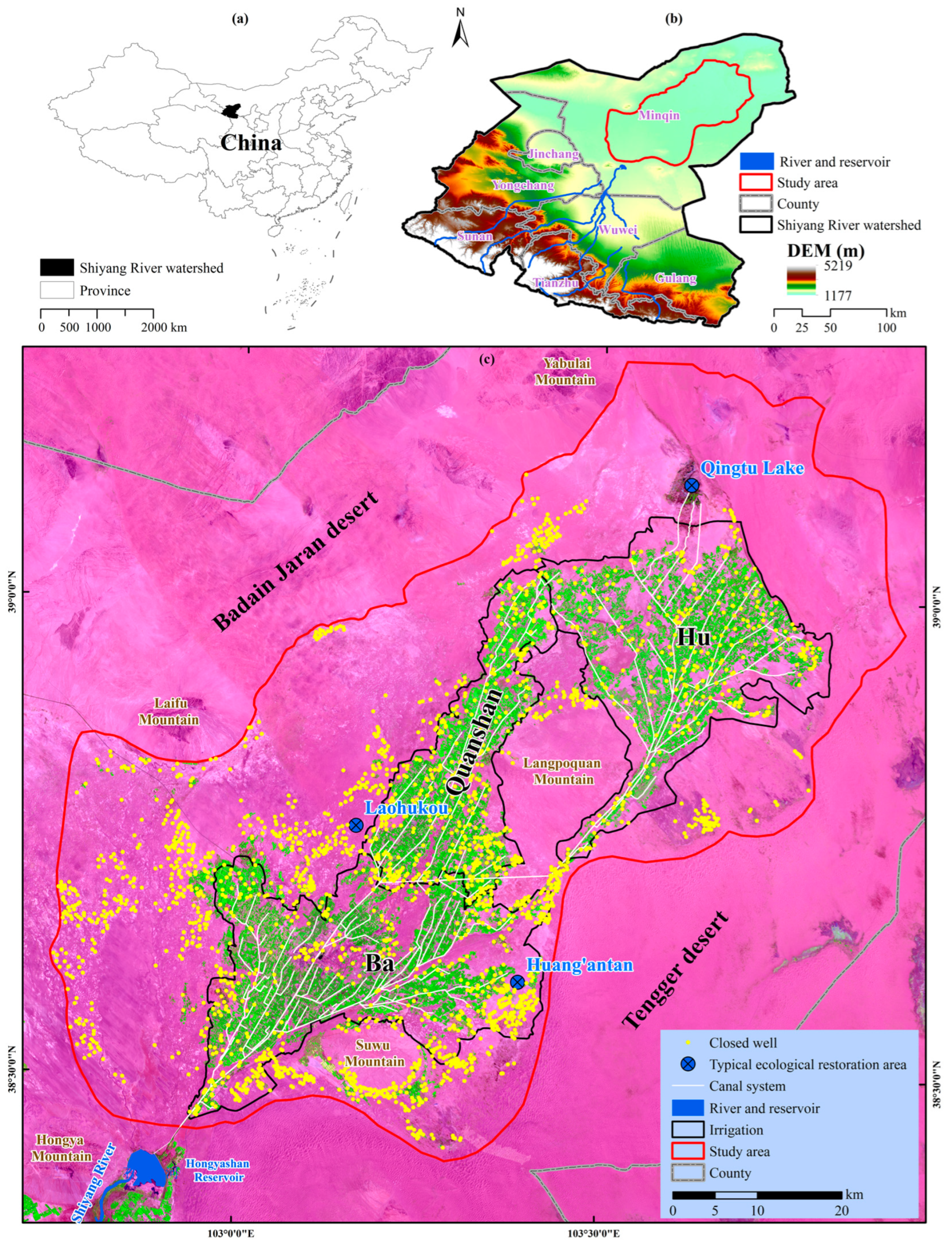

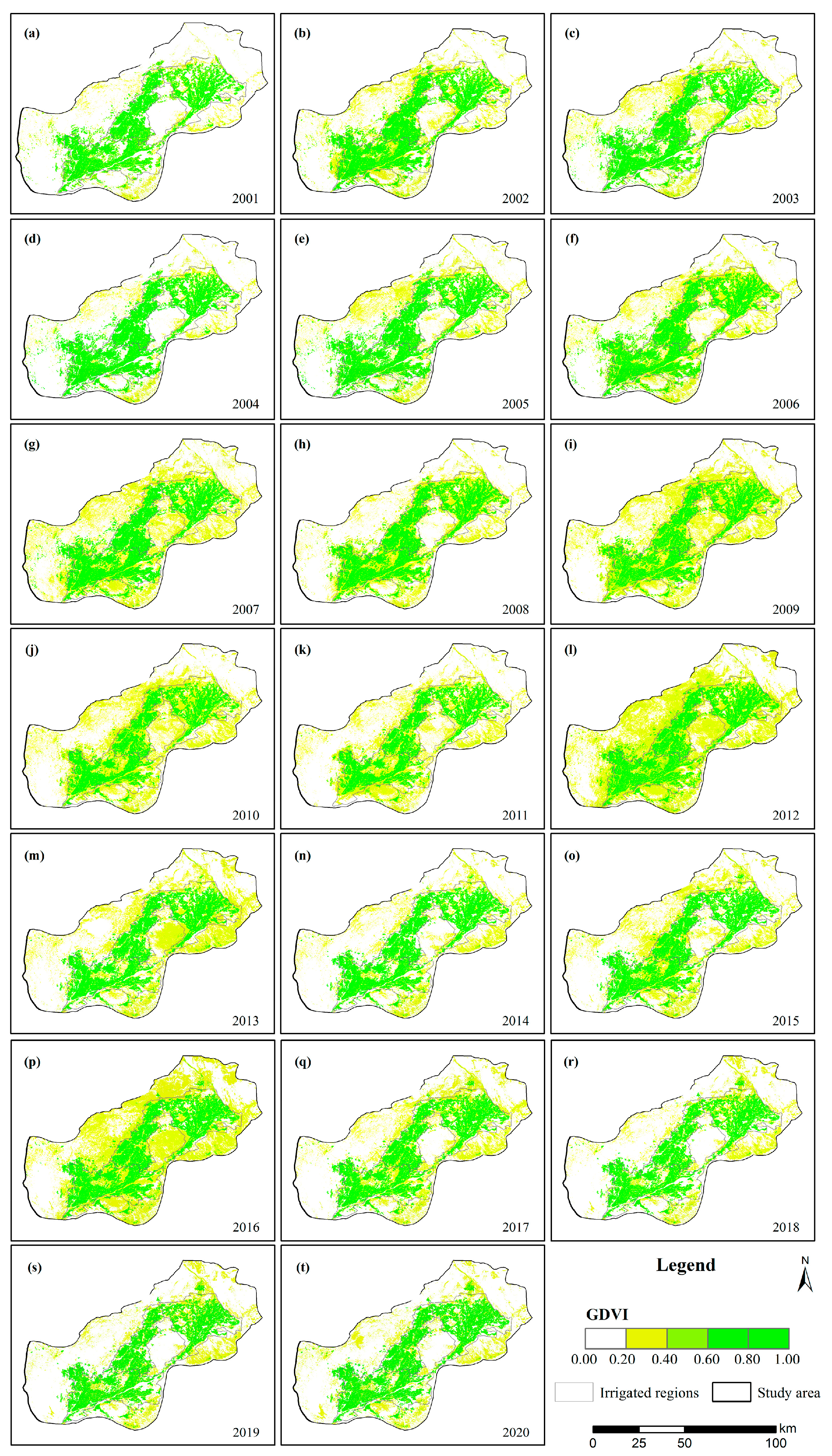
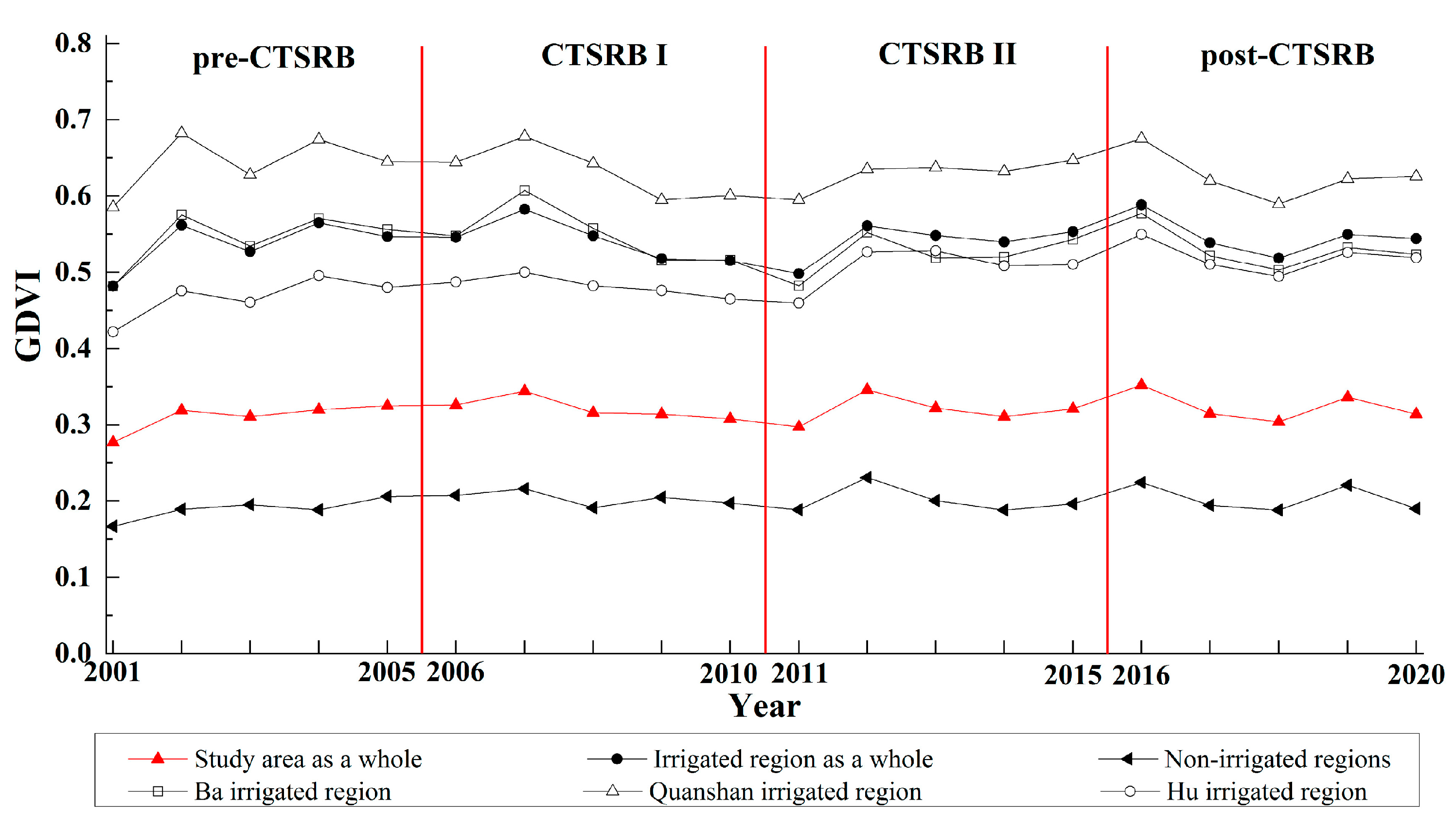
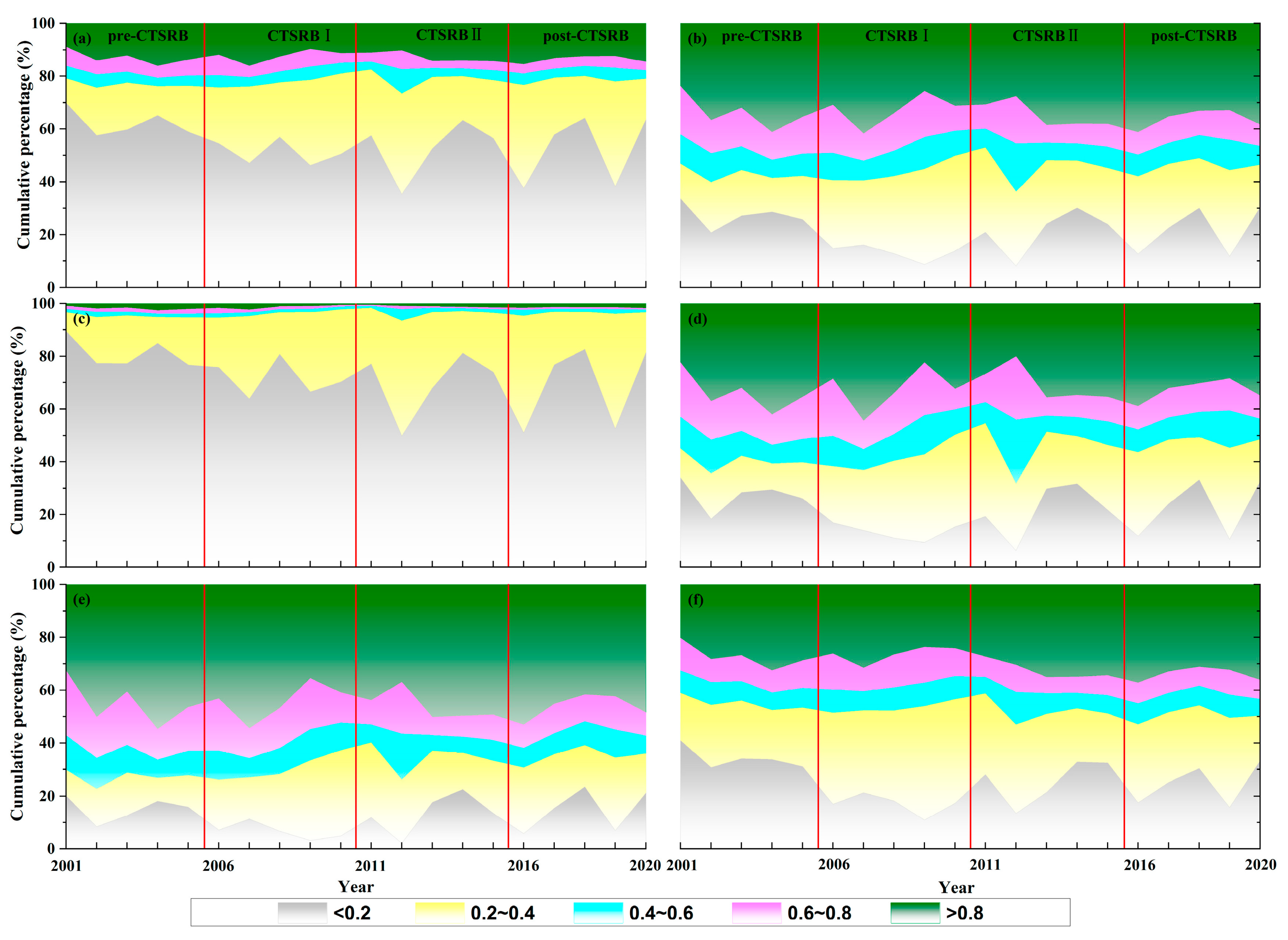
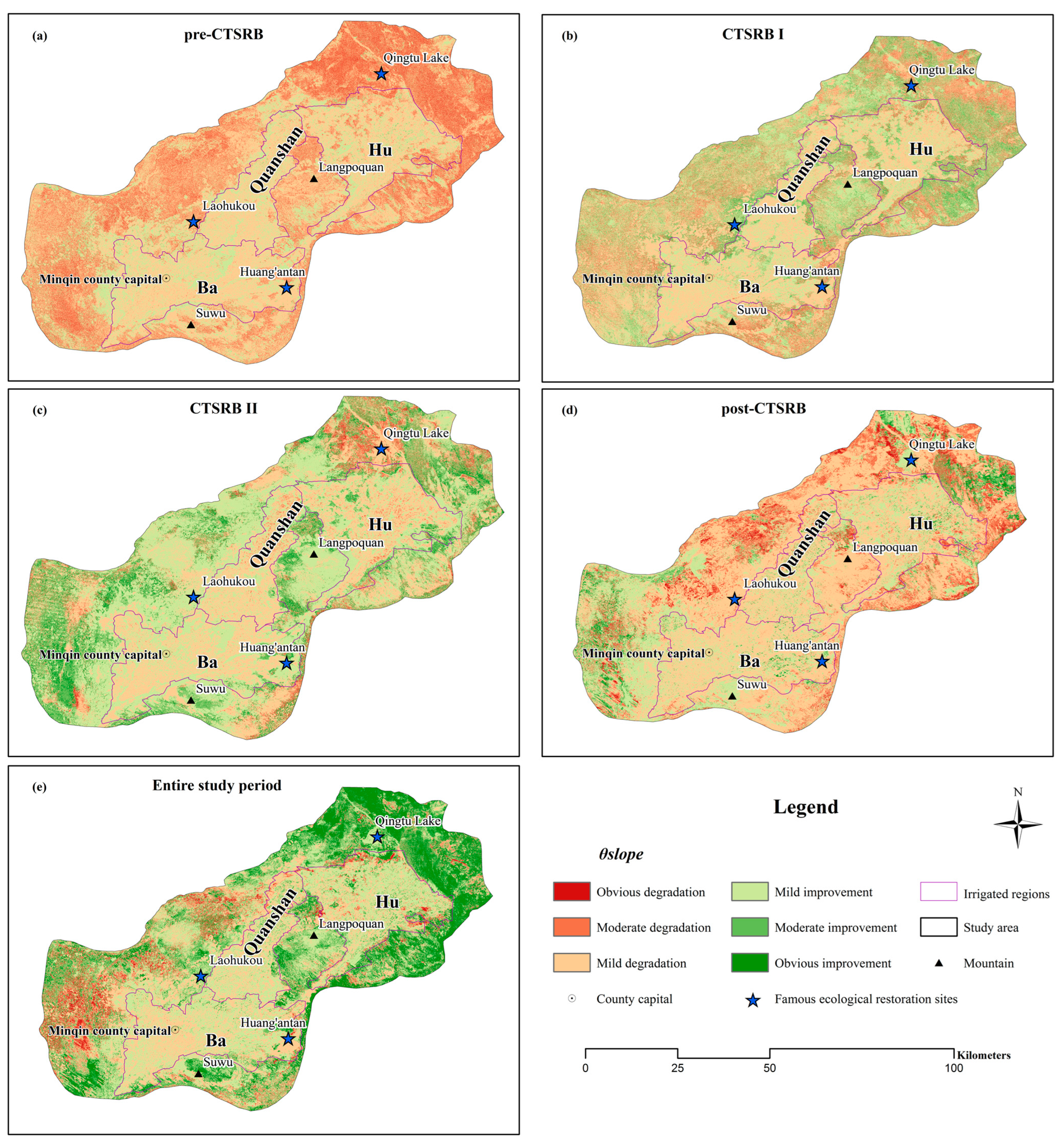


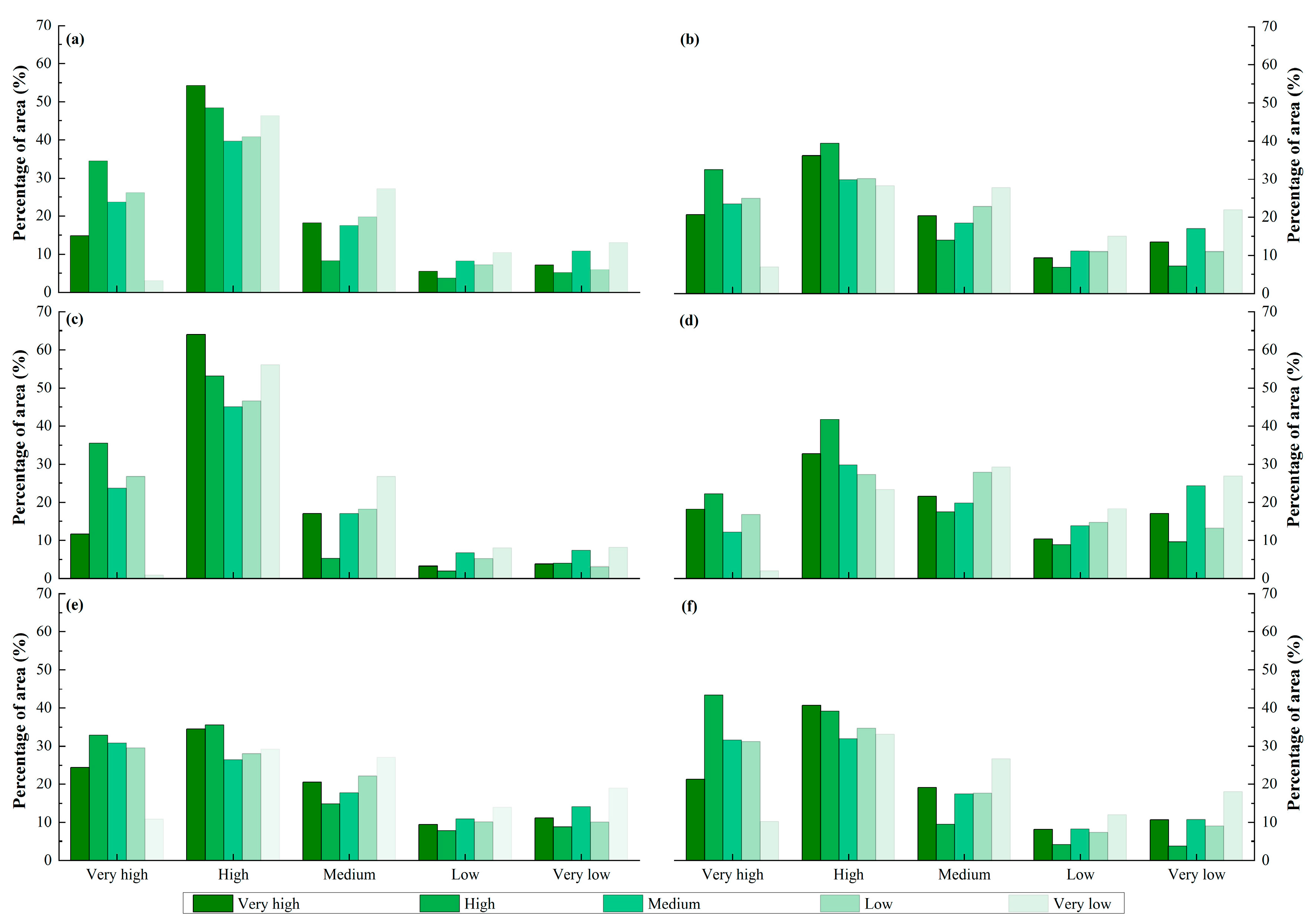
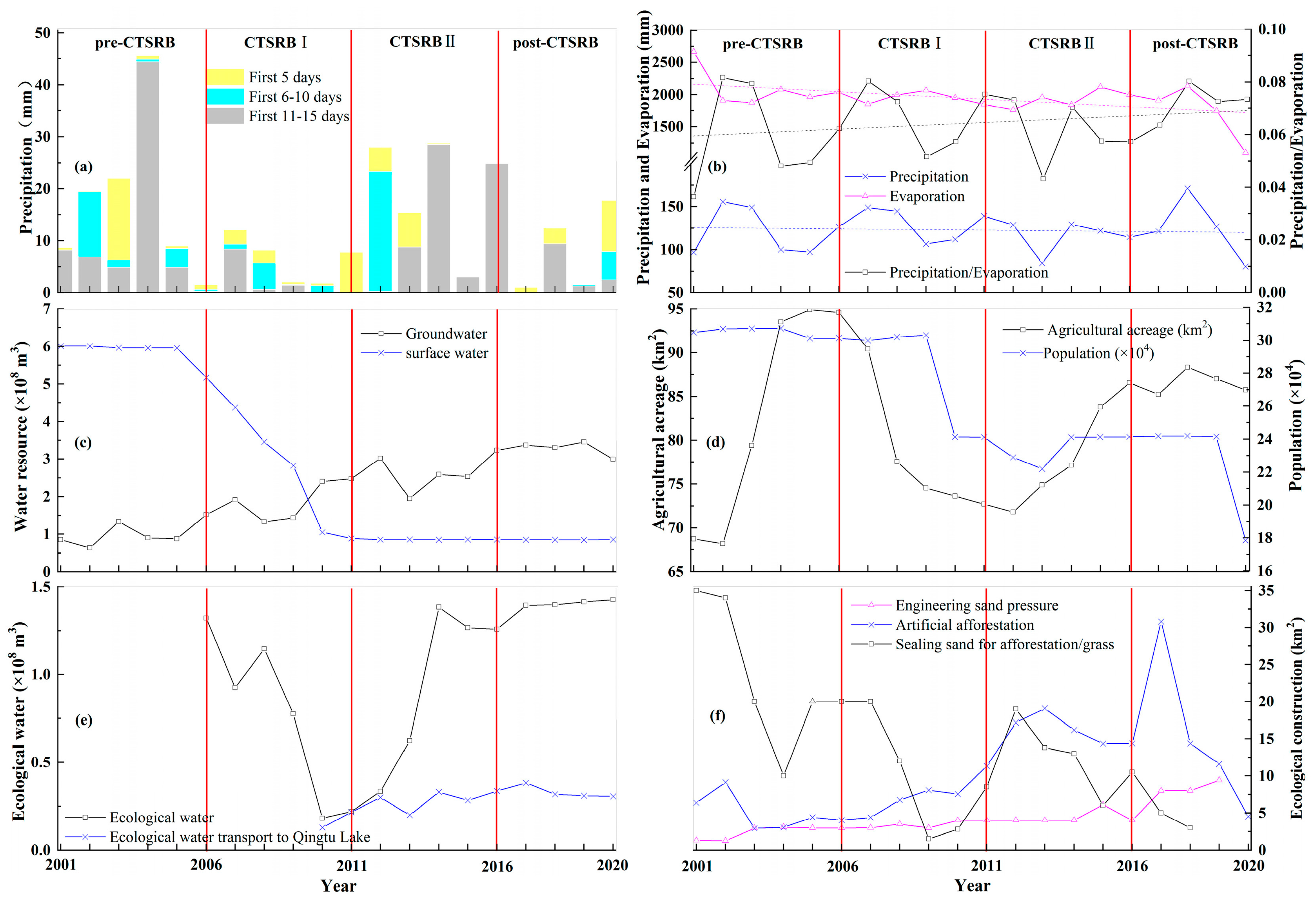

| Grade | Types | Classification Standard |
|---|---|---|
| I | obvious degradation | ≤−0.010 |
| II | moderate degradation | (−0.010, −0.005] |
| III | mild degradation | (−0.005, 0.000] |
| IV | mild improvement | (0.000, 0.005] |
| V | moderate improvement | (0.005, 0.010] |
| VI | obvious improvement | >0.010 |
Disclaimer/Publisher’s Note: The statements, opinions and data contained in all publications are solely those of the individual author(s) and contributor(s) and not of MDPI and/or the editor(s). MDPI and/or the editor(s) disclaim responsibility for any injury to people or property resulting from any ideas, methods, instructions or products referred to in the content. |
© 2023 by the authors. Licensee MDPI, Basel, Switzerland. This article is an open access article distributed under the terms and conditions of the Creative Commons Attribution (CC BY) license (https://creativecommons.org/licenses/by/4.0/).
Share and Cite
Hao, Y.; Liu, X.; Xie, Y.; Hua, L.; Liu, X.; Liang, B.; Wang, Y.; Huang, C.; He, S. A Landscape Restoration Initiative Reverses Desertification with High Spatiotemporal Variability in the Hinterland of Northwest China. Land 2023, 12, 2122. https://doi.org/10.3390/land12122122
Hao Y, Liu X, Xie Y, Hua L, Liu X, Liang B, Wang Y, Huang C, He S. A Landscape Restoration Initiative Reverses Desertification with High Spatiotemporal Variability in the Hinterland of Northwest China. Land. 2023; 12(12):2122. https://doi.org/10.3390/land12122122
Chicago/Turabian StyleHao, Yuanyuan, Xin Liu, Yaowen Xie, Limin Hua, Xuexia Liu, Boming Liang, Yixuan Wang, Caicheng Huang, and Shengshen He. 2023. "A Landscape Restoration Initiative Reverses Desertification with High Spatiotemporal Variability in the Hinterland of Northwest China" Land 12, no. 12: 2122. https://doi.org/10.3390/land12122122
APA StyleHao, Y., Liu, X., Xie, Y., Hua, L., Liu, X., Liang, B., Wang, Y., Huang, C., & He, S. (2023). A Landscape Restoration Initiative Reverses Desertification with High Spatiotemporal Variability in the Hinterland of Northwest China. Land, 12(12), 2122. https://doi.org/10.3390/land12122122






